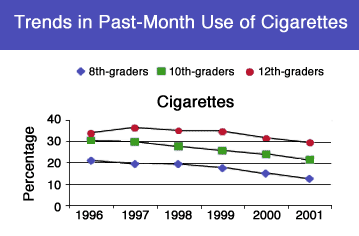Use of cigarettes by American teenagers decreased from 2000 to 2001, according to the annual Monitoring the Future Study. Smoking was down for 8th- and 10th-graders, continuing a general pattern of declines seen among these students and 12th-graders since 1997.
Overall illicit drug use by teenagers in 2001 was essentially unchanged from rates reported in 2000, the study found. Among 8th-graders, 11.7 percent said they had used some illicit drug within the preceding month, and 19.5 percent said they had used within the preceding year. Among 10th-graders, 22.7 percent reported past-month use and 37.2 percent reported past-year use. One in four high school seniors (25.7 percent) reported past-month use; 41.4 percent of seniors said they had used an illicit drug in the preceding year. Use of any illicit drug has remained stable among 10th- and 12th-graders since its recent peak in 1997, but among 8th-graders the rate in 2001 is lower than that reported for 1996.
 Among 8th-graders, 12.2 percent reported past-month cigarette use in 2001; this is the lowest rate reported since researchers began gathering smoking data on teenagers in 1991.
Among 8th-graders, 12.2 percent reported past-month cigarette use in 2001; this is the lowest rate reported since researchers began gathering smoking data on teenagers in 1991.In 2001, 12.2 percent of 8th-graders -- down from 14.6 percent in 2000 -- said they had used cigarettes in the preceding month. Among 10th-graders, past-month smoking decreased from 23.9 percent in 2000 to 21.3 percent in 2001. Smoking among high school seniors fell slightly, to 29.5 percent in 2001 from 31.4 percent the year before.
Although more teens in grades 8 (1.8 percent), 10 (2.6 percent), and 12 (2.8 percent) reported past-month use of MDMA (ecstasy) in 2001 than in 2000, the increases were generally not as steep as in the preceding 2 years and were not statistically significant.
"It is encouraging that the trend toward more widespread use of MDMA in 1999 and 2000 appears to have slowed last year," says NIDA Acting Director Dr. Glen Hanson. "The 2001 survey data also show that greater numbers of high school seniors -- nearly half of them, in fact -- say they believe there is a great risk in using MDMA. We hope that NIDA's efforts to provide science-based information about the risks of drugs will contribute to further decrease in drug use."
Although patterns of illicit drug use by teens were largely unchanged in 2001, trends for use of some drugs showed significant change from 2000 to 2001:
- Steroids: Among high school seniors, past-month use increased from 0.8 to 1.3 percent, and past-year use increased from 1.7 to 2.4 percent.
- Heroin: Past-year use by 10th-graders decreased from 1.4 to 0.9 percent. Among seniors, past-year use decreased from 1.5 to 0.9 percent, and past-month use decreased from 0.7 to 0.4 percent.
- LSD: Past-month use by seniors increased from 1.6 to 2.3 percent, but past-year use by 10th-graders declined from 5.1 percent to 4.1 percent.
Monitoring the Future
The Monitoring the Future Study, funded by NIDA, is conducted by the Institute for Social Research at the University of Michigan in Ann Arbor. Data in the 2001 survey represent responses from more than 44,000 students in 424 schools across the Nation to questions about lifetime use, use during the past year, use during the past month, and daily use of various illicit drugs, alcohol, cigarettes, and smokeless tobacco. The survey also asks students about their perception of the risks associated with drugs.
Additional information about the Monitoring the Future Study can be obtained from from the University of Michigan's Monitoring the Future home page: monitoringthefuture.org. Information about MDMA (ecstasy) is available at, https://www.drugabuse.gov/drugs-abuse/mdma-ecstasymolly, and about steroids at: https://www.drugabuse.gov/drugs-abuse/steroids-anabolic.
